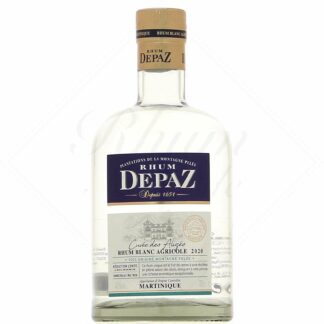Depaz

The history of Depaz rum
Depaz is a distillery based in Saint-Pierre, in the northwest of Martinique. It is established on the site of one of the island's first plantations, founded in 1639. Called "Domaine de la montagne" at the time, it flourished on the rich soil of the slopes of Montagne Pelée. Sugar cane, tobacco and indigo were planted, and two sugar mills were soon erected. After the sugar crisis, a distillery replaced the sugar mill, and the first rums were produced here in 1880.
The eruption of the volcano in 1902 completely destroyed the farm, which was then abandoned for several years. In 1917, Victor Depaz was the only survivor of a family established in Martinique since the 18th century. Having gone to Bordeaux to study, he was saved from the disaster, but lost around sixty members of his family. After learning the cane trade in Petit-Bourg (Rivière Salée), he was one of the few to restart a business on the ruins of the cataclysm. He then planted his cane around the recently acquired estate, on a terroir increasingly rich in volcanic ash.
In 1920, he built a new home and a distillery. He farms 134 hectares of sugar cane on the Caribbean side of the mountain. Depaz rums won a medal at the Marseille exhibition in 1922. A rarity at the time, Victor Depaz was already aging a large proportion of his rum in casks.
In the 1980s, the farm achieved very good yields, while switching to mechanized cutting. Surplus cane, not processed by the distillery, is sold to neighboring Neisson.
Grouping distilleries
In 1989, the company merged with its main customer, Bardinet: Bardinet. This was followed by a phase of modernization that lasted until 1994, tripling production.
In 1998, fate struck the Habitation Depaz with a terrible fire, accidentally ignited by welding in the air impregnated with alcohol vapors from the cellars. 700,000 liters of rum contained in the aging barrels went up in smoke. This event explains the scarcity of vintages from the years preceding the accident.
A further modernization took place in 2006, doubling production once again. The distillery now also obtains its supplies from other plots on the wetter, Atlantic side of the mountain. It can now count on 250 hectares of sugar cane.
Depaz rum production
Over the last 15 years, the Depaz estate has developed a number of initiatives that have enabled it to achieve a positive energy balance. The principles of sustainable agriculture are at the forefront: insect trapping, mechanical soil cultivation and very precise plot monitoring limit the use of herbicides, pesticides and fertilizers.
From an energy point of view, the distillery is equipped with photovoltaic installations. Bagasse from cane pressing is used as fuel for the steam engine. The remainder is transformed into compost, to be spread on the cane fields as fertilizer.
The vinasse is specially treated and spread on the fields as a mineral fertilizer.
Depaz on the technical side
Depaz rums are certifiedAOC Martinique. The cane varieties used are mainly blue cane (60%), cinnamon cane and zikak cane. The vesou is not diluted very much before fermentation, so we use well-adapted baker's yeasts, as the sugar concentration is high. Fermentation takes place in temperature-controlled vats over 48 hours. It produces a vesou with 6% alcohol.
Distillation takes place on Creole columns, one made of copper and stainless steel, the other entirely of copper. On average, 72% of the rum is distilled.
Since the early 2000s, a Cuban cellar master has been in charge of ageing. Nora Carrion-Martinez brings a wealth of experience to the table, with methods that are unheard of in Martinique, such as not reducing the rum before casking. Typically, the house blends are composed of 80% rums aged in first-fill ex-bourbon barrels, and 20% rums aged in old cognac barrels. These rums are then reduced with the exceptionally pure water flowing from Montagne Pelée.
The Depaz range of rums
The Depaz range of rums is extensive, so there's something for everyone. It starts with great white rhums de terroir (50 and 55%), for exceptional ti'punches. Depaz Blanc Cuvée de la Montagne, for its part, has been designed to be enjoyed as a brandy. The rhum doré also works wonders in ti'punch, but lends itself to other cocktails too.
Old rums also offer exceptional quality. For example, Depaz Vieux Plantation is not just a 3-year-old, but has an age count of at least 4 years. Similarly, VSOP is aged for at least 7 years, and Depaz Grande Réserve XO is a blend of rums aged 8 to 10 years.
Special series complete the collection, such as the Cuvée Prestige XO, the Port finish, single casks and brut de fûts, which are phenomenally successful. Read less
















